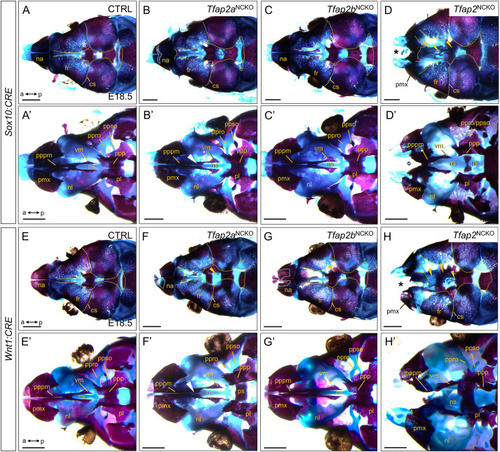
Formation of midfacial bone and cartilage structures depends on Tfap2a and Tfap2b gene dose in CNCCs. (A-H′) Alizarin Red (bone) and Alcian Blue (cartilage) staining preparations of E18.5 Sox10:CRE (A-D) or Wnt1:CRE (E-H) animals, with indicated genotypes and maxilla removed. n=5 per genotype. Scale bars: 1 mm. Anterior (a) is towards the left, posterior (p) towards the right. (A-H) Top-down views of the midfacial skeleton. Gold dashed lines (A-H) outline the peripheral edges of the calvaria bones. White dashed lines (B,F,G) outline nasal bone gaps. Gold arrowheads (D,F-H) indicate cartilaginous ectopias adjacent to the frontal bones. Asterisks (D,H) highlight missing nasal bones. (A′-H′) Bottom-up views of the midfacial skeleton. White arrowheads (B′,F′) indicate a gap in the vomer bones. cs, coronal suture; fr, frontal bone; na, nasal bone; nl, nasal/ethmoid labyrinth; ns, nasal septum; pl, palatine bone; pmx, premaxilla; ppp, palatal process of the palatine; pppm, palatal process of the premaxilla; ppro, pila preoptica; ppso, pila postoptica; ps, presphenoid; vm, vomer bone.
|